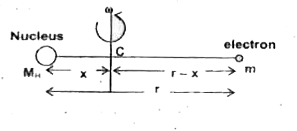In the ground state in ...A... electrons are in stable equilibrium while in ...B... electrons always experiences a net force. Here, A and B refer to
Dalton's theory, Rutherford model
Rutherford's model, Bohr's model
Thomson's model, Rutherford's model
Rutherford's model, Thomson's model
The correct Answer is:C
To solve the question, we need to identify the models of atomic structure referred to as A and B based on the behavior of electrons in their ground states.
1. Understanding the Ground State:
- The ground state of an atom is the lowest energy state where electrons are in stable positions around the nucleus.
2. Identifying Model A:
- In Model A, electrons are in stable equilibrium. This indicates that the forces acting on the electrons balance out, leading to a stable configuration.
- The Thomson model of the atom, also known as the "plum pudding model," suggests that electrons are embedded in a positively charged "soup," allowing them to remain stable without experiencing a net force.
3. Identifying Model B:
- In Model B, electrons experience a net force. This suggests that the electrons are not in a stable equilibrium and are subject to forces that cause them to accelerate.
- The Rutherford model describes electrons moving in orbits around a nucleus, where they are subject to centripetal force. This model indicates that electrons would spiral into the nucleus due to the attractive force, leading to instability.
4. Conclusion:
- Therefore, based on the descriptions:
- Model A refers to Thomson's model (where electrons are in stable equilibrium).
- Model B refers to Rutherford's model (where electrons experience a net force and are unstable).
Final Answer:
A refers to Thomson's model, and B refers to Rutherford's model.
---
- The ground state of an atom is the lowest energy state where electrons are in stable positions around the nucleus.
- In Model A, electrons are in stable equilibrium. This indicates that the forces acting on the electrons balance out, leading to a stable configuration.
- The Thomson model of the atom, also known as the "plum pudding model," suggests that electrons are embedded in a positively charged "soup," allowing them to remain stable without experiencing a net force.
- In Model B, electrons experience a net force. This suggests that the electrons are not in a stable equilibrium and are subject to forces that cause them to accelerate.
- The Rutherford model describes electrons moving in orbits around a nucleus, where they are subject to centripetal force. This model indicates that electrons would spiral into the nucleus due to the attractive force, leading to instability.
- Therefore, based on the descriptions:
- Model A refers to Thomson's model (where electrons are in stable equilibrium).
- Model B refers to Rutherford's model (where electrons experience a net force and are unstable).
A refers to Thomson's model, and B refers to Rutherford's model.
Topper's Solved these Questions
- BOOK - DISHA PUBLICATIONCHAPTER - ATOMSEXERCISE - EXERCISE-2: CONCEPT APPLICATOR30videos
ATOMS
- BOOK - DISHA PUBLICATIONCHAPTER - ATOMSEXERCISE - EXERCISE-2: CONCEPT APPLICATOR30videos
ATOMS
- BOOK - DISHA PUBLICATIONCHAPTER - ALTERNATING CURRENT EXERCISE - Exercise -2 : Concept Applicator30videos
ALTERNATING CURRENT
- BOOK - DISHA PUBLICATIONCHAPTER - CHAPTERWISE NUMERIC /INTEGER ANSWER QUESTIONSEXERCISE - CHAPTER 29 : (COMMUNICATION SYSTEMS)15videos
CHAPTERWISE NUMERIC /INTEGER ANSWER QUESTIONS
Similar Questions
Choose the correct alternative from the clues given at the end of the each statement :
In the ground state of .......... electrons are in stable equilibrium, while in ....... electrons always experience a net force.
(Thomson's model/Rutherford's model)View SolutionChoose the correct alternative form the clues given at the end of each statement:
(a) The size of the atom in Thomson's model is ........... the atomic size in Rutherford's model (much greater than/no different form/much less than)
(b) In the ground state of ..........., electrons are in stable equilibrium, while in.......... electrons always experience a net force (Thomson's model/Rutherford's model).
(c) A classical atom based on ......... is doomed to collapse (Thomson's model/Rutherford's model).
(d) An atom has a nearly continous mass distribution in ......... but has highly non uniform mass distribution in....... (Thomson's model/Rutherford's model).
(e) The positively charge part of the atom possesses most of the mass of the atom in .......... (Rutherford's ,model /both the models).View Solution
Knowledge Check
- Question 1 - Select One

The new ground state energy of electron will beAmore than that found with Bohr atomBequal to energy found with Bohr atomCsmaller than energy found with Bohr atomDdata insufficient - Question 2 - Select One
The ground state electronic configuration of platinum is
A[Xe]4f145d96s1B[Kr]4d105s0C[Xe]4f145d86s2D[Kr]4d45s1 - Question 3 - Select One
The ground state electronic configuration of neutral titanium atom is
A[Ar]4s24p2B[Ar]3d24s2C[Ar]4s2p1xp1yD[Ar]3d5
The ground state electronic configuration of CO molecule
View Solution…..A …. And B…. Are the example of intrinsic semiconductors . Here , A and B refer to
View Solutionthe ground state electronic configuration of chromium can be written as
View SolutionThe ground state electronic configuration of chromium is against
View SolutionThe ground state electronic configuration of chromium is against
View Solution

